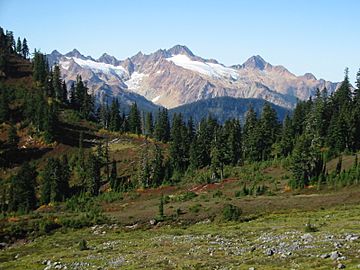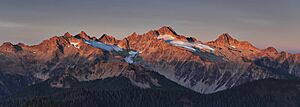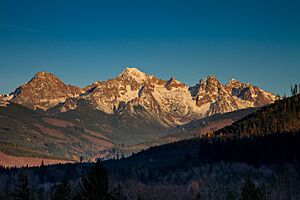Twin Sisters Mountain facts for kids
Quick facts for kids Twin Sisters Mountain |
|
|---|---|

As seen from southern flank of Mount Baker
|
|
| Highest point | |
| Elevation | 7,000+ feet (2,130+ m) |
| Prominence | 3,520 ft (1,070 m) |
| Geography | |
| Location | Whatcom County, Washington, U.S. |
| Parent range | Cascade Range |
| Topo map | USGS Twin Sisters Mountain |
| Geology | |
| Mountain type | Igneous dunite |
Twin Sisters Mountain, also known as the Twin Sisters, is a cool mountain in the state of Washington, USA. The local Nooksack people call it Kwetl’kwítl’ Smánit, which means "red mountain." This mountain is part of the Cascade Range, a big chain of mountains. It sits just southwest of the famous Mount Baker.
Twin Sisters Mountain has two main peaks. The South Twin peak is taller, reaching over 7,000 feet high. The North Twin peak is a bit shorter, at over 6,600 feet. You can also find several glaciers on the northeast sides of the mountain.
Where Are the Twin Sisters Located?
Both of the mountain's peaks are found inside the Mount Baker Wilderness. This is a special area protected for nature and wildlife. Twin Sisters Mountain is southwest of Mount Baker. A river called the Middle Fork of the Nooksack River separates the two mountains. The South Fork Nooksack River flows around the eastern side of Twin Sisters Mountain. Other smaller streams, like Skookum Creek and Sister Creek, also flow from the mountain. All these streams eventually join the Nooksack River.
What Is Twin Sisters Mountain Made Of?
Twin Sisters Mountain is mostly made of a unique rock called dunite. Dunite is an igneous rock, which means it formed from cooled magma deep inside the Earth. It's mostly made of a mineral called olivine, which often has a greenish color. The reddish color you might see on the mountain comes from iron and magnesium in the dunite. When these minerals are exposed to air and water, they can rust, making the rock look red.
Scientists believe the Twin Sisters Range was pushed up from deep underground. This happened because of huge forces in the Earth's crust. It was like a giant slab of rock being forced upwards during a time called the Mesozoic era. This was when different parts of the Earth's crust, called terranes, crashed into each other.
Besides olivine, the dunite also contains other minerals like chromite and clinopyroxene. These minerals usually form very deep inside the Earth, in the mantle, which is the layer below the crust. Some parts of the rock also have serpentinite. This mineral likely formed later when water seeped into cracks in the rock during the mountain's uplift.
What Is the Climate Like?
The Twin Sisters Mountain is in a place with a "marine west coast climate." This means it gets a lot of influence from the Pacific Ocean. Most of the weather systems, like storms, come from the Pacific Ocean and move towards the Cascade Range.
When these weather systems hit the tall Cascade Mountains, they are forced to rise. As the air rises, it cools down and drops its moisture. This causes a lot of rain or snow to fall on the western side of the mountains. Because of this, the Twin Sisters area gets a lot of precipitation, especially heavy snowfall in winter.
Winters are usually cloudy. However, in summer, high-pressure systems over the Pacific Ocean often bring clear skies. The snow in this area tends to be wet and heavy. This can create a high risk of avalanches, which are dangerous slides of snow down the mountain.



